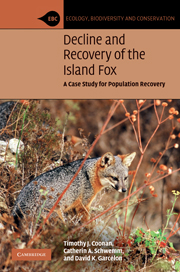Book contents
- Frontmatter
- Contents
- Foreword
- Acknowledgments
- 1 Introduction
- 2 Evolution and genetics
- 3 Social structure, reproduction, mortality and survivorship, and population dynamics
- 4 Food habits, habitat use, activity patterns, and dispersal
- 5 Golden eagles and the decline on the northern islands
- 6 Ecosystem recovery
- 7 Disease and decline on Santa Catalina Island
- 8 Recovery actions
- 9 Recovery actions
- 10 Reproductive biology, by Cheryl Asa
- 11 Diseases of island foxes, by Linda Munson
- 12 Zoos, education, and public participation
- 13 Managing recovery
- 14 The ecological role of island foxes
- 15 Conclusion
- References
- Index
4 - Food habits, habitat use, activity patterns, and dispersal
Published online by Cambridge University Press: 05 October 2010
- Frontmatter
- Contents
- Foreword
- Acknowledgments
- 1 Introduction
- 2 Evolution and genetics
- 3 Social structure, reproduction, mortality and survivorship, and population dynamics
- 4 Food habits, habitat use, activity patterns, and dispersal
- 5 Golden eagles and the decline on the northern islands
- 6 Ecosystem recovery
- 7 Disease and decline on Santa Catalina Island
- 8 Recovery actions
- 9 Recovery actions
- 10 Reproductive biology, by Cheryl Asa
- 11 Diseases of island foxes, by Linda Munson
- 12 Zoos, education, and public participation
- 13 Managing recovery
- 14 The ecological role of island foxes
- 15 Conclusion
- References
- Index
Summary
Island foxes interact with their habitats in ways that illustrate the near-optimal conditions of the environments in which they live. Foxes utilize nearly all available animal and plant resources, so there is ample food, and nearly all vegetation communities on the islands provide at least marginal if not high-quality habitat. Foxes adapted to the natural absence of predators by acquiring more diurnal (daytime) behavior patterns, and the combination of plentiful resources and tolerance for high population densities make foxes less inclined to disperse great distances in comparison to other species. This chapter examines the food habits, foraging behavior, habitat requirements, and dispersal tendencies of island foxes in wild populations.
Food habits
Animal prey
Like other members of the genus Urocyon, island foxes are omnivorous, utilizing both plant and animal material in their diets (Moore and Collins 1995). Deer mice (Peromyscus maniculatus ssp.) are the most common animal prey taken by island foxes. Deer mice are present on all of the islands, and are the only native rodent on Santa Rosa, San Miguel, and San Nicolas. On San Miguel, the percent occurrence of mice in fox scats in several studies ranged from 10% to over 90% across all seasons (Collins 1980, Crowell 2001). Although mice are a common prey item, the quantity of mice in fox diets does not necessarily reflect mouse availability. Mouse abundance is highest in the summer and fall, following spring reproduction, and low in the winter and early spring due to winter mortality.
- Type
- Chapter
- Information
- Decline and Recovery of the Island FoxA Case Study for Population Recovery, pp. 34 - 42Publisher: Cambridge University PressPrint publication year: 2010
- 2
- Cited by



